Papers by John F Connolly
Archives of Physical Medicine and Rehabilitation, 1999
Connolly JF, Mate-Kole CC, Joyce BM. Global aphasia: an innovative assessment approach. Arch Phys... more Connolly JF, Mate-Kole CC, Joyce BM. Global aphasia: an innovative assessment approach. Arch Phys Med Rehabil 1999;SO: 1309-15.
Journal of Neurology Neurosurgery and Psychiatry, 1982
An experiment is described which compared visual evoked potential (VEP) amplitudes and latencies ... more An experiment is described which compared visual evoked potential (VEP) amplitudes and latencies in normal subjects and migraine patients. Several VEP abnormalities were found: at vertex and to a lesser extent at temporal sites, P100-N120 amplitudes were larger in patients; at vertex and temporal sites N120 amplitudes were larger in patients; at temporal sites patents had larger N120-P200 amplitudes but
We used magnetoencephalography to elucidate the cortical activation associated with the segmentat... more We used magnetoencephalography to elucidate the cortical activation associated with the segmentation of spoken words in nonreading-impaired and dyslexic adults. The subjects listened to binaurally presented sentences where the sentence-ending words were either semantically appropriate or inappropriate to the preceding sentence context. Half of the inappropriate final words shared two or three initial phonemes with the highly expected semantically appropriate
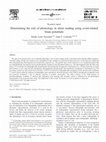
Cognitive Brain Research, 2004
The goal of the present study was to delineate phonology's role in silent reading using event-rel... more The goal of the present study was to delineate phonology's role in silent reading using event-related brain potential (ERP) techniques. Terminal endings of high cloze sentences were manipulated in four conditions in which the terminal word was: (1) the high cloze ending and thus orthographically, phonologically and semantically congruent (e.g., The gambler had a streak of bad luck.); (2) a pseudohomophone that was orthographically incongruent, but was phonologically congruent to the anticipated ending (e.g., The ship disappeared into the thick phog [fog].); (3) a word that was orthographically, phonologically and semantically incongruent to expectations (e.g., The dog chased the cat up the Queen [tree].); or (4) a nonword and consequently orthographically, phonologically and semantically incongruent to expectations (e.g., The gas station is about two miles down the bole [road].). A N270 was elicited by orthographically incongruent words and nonwords (conditions 2, 3 and 4), likely reflecting violations of orthographic form expectations, while the presence of the N400 to semantically incongruent words and nonwords (conditions 3 and 4) reflected violations of semantic expectations. The relative absence of the N400 response to pseudohomophones (condition 3) indicates that integrating word meaning with sentential context is influenced by the phonological representation of the presented letter string. The implication of these results for theories of word recognition is discussed. D
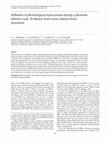
Psychophysiology, 2003
Several studies have identified a negativity [the phonological mismatch negativity (PMN)] precedi... more Several studies have identified a negativity [the phonological mismatch negativity (PMN)] preceding the N400 during auditory sentence comprehension. The present study investigated whether the PMN reflects a prelexical or lexical stage of spoken word recognition. Event-related brain potentials (ERPs) were recorded to investigate phonological processing independently from lexical/semantic influences during a task requiring metalinguistic analysis of speech stimuli. Participants were instructed to omit the initial phoneme from a word (''clap'' without the/k/) after which they heard a correct (lap) or incorrect (cap, ap, nose) answer. The PMN (peaking at 270 ms) was largest to incorrect items and did not differentiate between items that shared the same rime and items that were phonologically unrelated to the correct choice. Further, the PMN did not differ between word (cap) and nonword (ap) choices. The P300 was largest to correct items but was also seen to choices that rhymed with the correct answer. It is concluded that the PMN serves as a neural marker for the analysis of acoustic input merging with prelexical phonemic expectations.
Psychological Medicine, 1981
Bilateral electrodermal orienting responses were measured to repeated auditory stimuli in schizop... more Bilateral electrodermal orienting responses were measured to repeated auditory stimuli in schizophrenic patients and controls. In 3 studies phasic activity to moderate intensity sounds of patients on no drugs or phenothiazines was predominantly hyper- or hypo-responsive. Controls showed moderate or slow habituation. Propranolol was found to facilitate habituation in slow habituators and to reinstate responses in half of non-responders, especially when given as the sole drug. The effects seldom had a counterpart in changes in non-specific responses or levels of skin conductance. Modulatory influences on stimulus and response processing and on lateral asymmetries in responses may underlie propranolol's efficacy in treating schizophrenia.

Neuroreport, 2001
We describe, for the first time, the use of high-resolution event-related brain potentials (hrERP... more We describe, for the first time, the use of high-resolution event-related brain potentials (hrERP) to identify the spatio-temporal characteristics of neural systems involved in phonological analysis. Subjects studied a visual word/non-word that was followed by the brief presentation of a prime letter (e.g. House, M) with the instruction to anticipate the word/non-word formed by replacing the word's first letter with the prime letter. After the prime letter, an auditory target word/non-word was presented that either matched/mismatched expectations (e.g., Mouse/Barn). ERPs were recorded to the onset of the auditory targets and scalp topographical maps were derived for the phonological mismatch negativity (PMN). The PMN reflected phonological analysis and examination of the peak topography revealed that the response was characterized by a prominent frontal, right-asymmetrical distribution. Spatial de-blurring (using current source density maps) indicated that the PMN scalp topography resulted primarily from an active left anterior source. The current results provide the initial evidence for the localization of the intra-cranial generator(s) involved in phonological analysis.
Journal of the International Neuropsychological Society, 2000
Evidence is presented for the efficacy of a new method of assessing reading comprehension using a... more Evidence is presented for the efficacy of a new method of assessing reading comprehension using a standardized reading test that was formatted for computer presentation with simultaneous event-related brain potential (ERP) recordings. Reading comprehension abilities of 23 healthy undergraduate students were evaluated using ERPs. The results revealed a differential ERP response pattern for correct and incorrect test items. These response patterns were observed at individual participant levels. The findings provided further support for the use of ERPs in the neuropsychological assessment of patients who are difficult or impossible to assess using behavioral responses because of concomitant motoric and/or communicative limitations.
Journal of Psychophysiology, 2006
1Department of Anesthesiology and Pain Medicine, University of Alberta, 2Cognitive/Clinical Neuro... more 1Department of Anesthesiology and Pain Medicine, University of Alberta, 2Cognitive/Clinical Neuroscience Unit (CCNU), Department of Psychology & Neuroscience Institute, Dalhousie University, Halifax, 3Department of Psychology, St. Thomas University, Fredericton, ...
Journal of Clinical and Experimental Neuropsychology, 2006
Communication difficulties are a common consequence of brain injury and neuropathological process... more Communication difficulties are a common consequence of brain injury and neuropathological processes. Equally common is the inability to assess intellectual functioning in many communication-impaired populations because the aphasia and physical disability of such patients prevents measurable performance on traditionally administered tests of mental functioning. This study demonstrates that concept formation abilities can be assessed using event-related brain potentials. It also provides further evidence for the efficacy of this innovative assessment method in which standardized and validated psychometric tests are formatted for computer presentation and simultaneous recording of neural activity, which serves as the response measure in lieu of verbal/behavioral responses.
Journal of Clinical and Experimental Neuropsychology (Neuropsychology, Development and Cognition: Section A), 1999
Assessment of intellectual functions is essential for rehabilitative interventions with traumatic... more Assessment of intellectual functions is essential for rehabilitative interventions with traumatic brain injury and stroke patients. However, many of these patients are difficult or impossible to assess because of aphasia and physical disabilities that prevent their performance on traditionally administered tests of mental functioning. We present normative evidence obtained from healthy individuals for the efficacy of a new method of assessing such patients using standardized and validated tests formatted for computer presentation and using direct measures of brain activity (event-related brain potentials, ERP) as the measurable response instead of verbal or motor behavior.

Journal of Child Neurology, 2001
The purpose of this study was to test the validity of a new computerized task to assess children&... more The purpose of this study was to test the validity of a new computerized task to assess children's cognitive problem-solving skills using the brain event-related potentials. This event-related potential-computerized cognitive problem-solving task does not require a child to give a verbal or motor (ie, pointing) response. The event-related potential waveforms were recorded from 20 typically developing children. Two nonverbal, problem-solving tasks (tasks 1 and 2) were developed for each of two age groups (5 and 6 years). For each task, single pictures, taken from an existing standardized test of nonverbal problem solving, were individually and sequentially presented on a computer screen. One of the seven pictures was classified as incongruent or outside category; it did not belong with the other pictures. As predicted, the event-related potential amplitudes were significantly larger to the outside- versus within-category pictures. This effect was found for tasks 1 and 2 for the 5- and 6-year-old children. Children as young as 5 years of age reliably exhibit brain activity, which can be used to infer cognitive problem-solving skill. This assessment paradigm may eventually serve as a clinically useful adjunct to a thorough neurologic and neurodevelopmental assessment of selected pediatric populations, such as those presenting with moderate-severe cerebral palsy whose expressive language and motor skills are notably impaired.
Journal of Abnormal Psychology, 1988
The import of a recent consensus that a distinctive subgroup of schizophrenics is marked by nonre... more The import of a recent consensus that a distinctive subgroup of schizophrenics is marked by nonreactivity of the orienting response (OR) to innocuous stimuli has been made ambiguous by reports of similar nonreactivity among depressives. To test this, we studied 50 schizophrenics (14 drug free), 50 depressives (20 drug free), and 50 normal controls. Stimuli were 1000 Hz (60 dB)
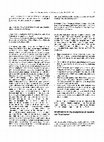
International Journal of Psychophysiology, 1998
It is known from preliminary experiments (Radilovl et al,, Homeostasis 39:30-31, 1998) that both ... more It is known from preliminary experiments (Radilovl et al,, Homeostasis 39:30-31, 1998) that both the shape (quadrilateral or circular) and the "depth" ("big", "medium" or "little" distance between perceived front and rear surface) influence the alternance rate of the multistable perception of ambiguous patterns such as a Necker cube or a "Necker drum". All the six parameters were tested in each single experiment. On the contrary, during each experiment of the present research we used only the extreme distances (big and little) of each shape, and we investigated the influence of only one type of pattern change. We utilized 10 healthy subjects, 5 males and 5 females, ranging from 30 to 65 years, ungraduated and graduated. A special purpose, specifically designed and implemented programming language was used for the multistablepattern presentation, subject-reaction monitoring and outputdata organization (Colucci et al., Int. J Bio-Medical Computing Abstracts
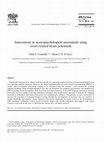
International Journal of Psychophysiology, 2000
Historically, clinicians have utilized evoked potentials for evaluating sensory functions and neu... more Historically, clinicians have utilized evoked potentials for evaluating sensory functions and neuropsychological tests Ž . for evaluating cognitive functions. However, the clinical implementation of event-related brain potentials ERPs , an on-line index of cognitive processing, remains to be developed fully. We describe a new method for assessing language functions using neuropsychological tests that are formatted for computer presentation with simultaneous ERP recordings. From its inception, there have been two major objectives of this ERP language assessment research. Practically, we have sought to develop assessment techniques that would enable clinicians to evaluate the language functions of individuals with limited behavioral and communicative abilities. Conceptually, we have endeavored to increase the precision of neuropsychological testing through the development of measures that are sensitive to readily identifiable and objective neural responses. This article summarizes the issues central to the development of ERP assessment techniques, reviews recent normative studies with healthy individuals, and suggests some future avenues of research in this area. ᮊ
International Journal of Psychophysiology, 2004
Event-related potentials were used as an adjunct to behavioral and self-report measures to examin... more Event-related potentials were used as an adjunct to behavioral and self-report measures to examine the impact of pain in a short-term memory-scanning task. P3 amplitude was reduced and a frontal slow wave was increased during pain regardless of the number of items in memory. Results are discussed in terms of pain affecting an attention-switch mechanism.
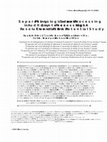
Human Brain Mapping, 2004
Phonological and semantic processing was studied using high-resolution event-related brain potent... more Phonological and semantic processing was studied using high-resolution event-related brain potentials (ERPs) during a sentence-matching task to investigate the spatial distribution of the phonological mismatch negativity (PMN) and the N400 response. It was hypothesized that the two components were spatially separable and that the activity matched prior localization knowledge. Participants examined visualauditory sentence pairs that related within a semantic hierarchy (e.g., visual: "The man is teaching in the classroom"; Auditory: "The man is in the…school/barn"). Semantic congruency was varied for the final words of the spoken sentences. Incongruent words mismatched expectation in terms of both the initial phonological features (unexpected sound) and semantic features (unexpected meaning). In addition, the category-exemplar probability of the final words was either high or low, with low probability words being more difficult to anticipate. Low probability words were predicted to selectively affect PMN activity. We found that incongruent words elicited a PMN (287 msec) and a N400 (424 msec), for both the high and low probability words. As expected, low probability congruent words elicited a small PMN but no N400. In contrast, high probability congruent words elicited neither a detectible PMN nor a N400. The primary PMN sources were in left inferior frontal and inferior parietal lobes. The primary N400 source activation occurred along the left perisylvian cortex, consistent with prior N400 source localization work. From these results, it was concluded that the PMN and N400 were localized to separate cortical language (and memory) regions and had different source activation patterns. Hum. Brain Mapp. 22:40-51, 2004.
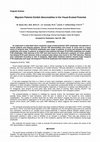
Headache: The Journal of Head and Face Pain, 1983
An experiment is described which compared visual evoked potential (VEP) amplitudes and latencies ... more An experiment is described which compared visual evoked potential (VEP) amplitudes and latencies in normal subjects and migraine patients. Several VEP abnormalities were found: at vertex and to a lesser extent at temporal sites, P100-N120 amplitudes were larger in patients; at vertex and temporal sites N120 amplitudes were larger in patients; at temporal sites patients had larger N120-P200 amplitudes but smaller P100 amplitudes. Peak latencies of the VEP were also found to be abnormal in patients. At vertex, patients had delayed N120 peak latencies while at temporal sites delays were found in the P200 latencies. Patients were subdivided according to side of headache. Right-sided headache patients showed larger temporal P100 amplitudes and larger left temporal P100-N120 amplitudes than bilateral headache patients. (Headache 23:49-52, 1983)
Developmental Medicine & Child Neurology, 1999

Uploads
Papers by John F Connolly